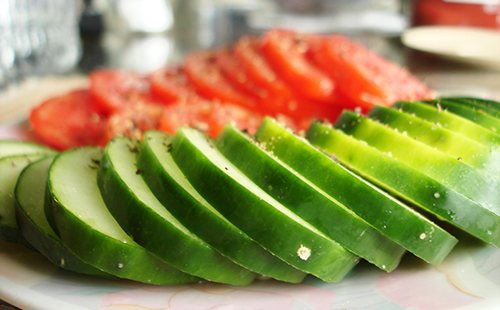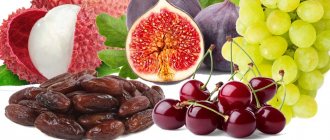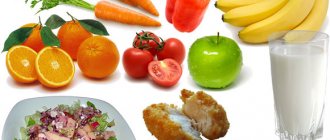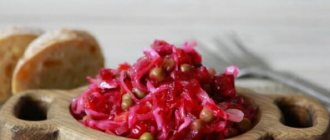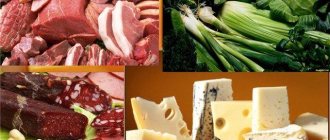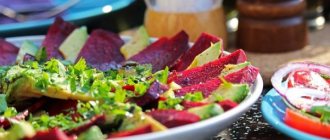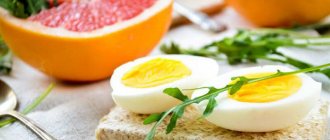Losing weight up to 8 kg in 14 days. The average daily calorie content is 690 Kcal.
A vegetable diet is a useful and effective method for transforming your figure. If during the vegetable season you want to get rid of excess fat ballast on your body, then it is best, as many experts note, to turn to this method. There are many methods for losing weight using vegetables (both in duration and in diet diversity). Choose the one that is right for you to make losing weight easy, enjoyable and effective.
Let's look today at the most popular options for vegetable body transformation, designed for 3, 7, 14 days and one month.
Vegetable diet requirements
We suggest starting your acquaintance with the types of vegetable diets with the shortest - three days
- option. If you’ve gone overboard on calories at holiday feasts, an excellent solution would be to work on your figure with this diet. On it, experts suggest consuming up to 1.8 kilograms of vegetables (any except potatoes) daily. You need to eat them raw, as well as boiled and baked. You can also prepare salads by adding a little vegetable oil to them. You can also season them with low-calorie mayonnaise. But for a more noticeable weight loss result, it would be wise to choose yogurt or kefir for salad dressing. In addition, these products are clearly healthier. The daily diet should be divided into approximately 5 servings and eaten when you feel hungry. In any version of the vegetable diet, you are allowed to drink clean water and unsweetened tea (preferably choose green). If you want to do a mini-unload and just give your gastrointestinal tract a rest, spend one day on vegetables.
A slightly longer method of losing weight is the seven-day
vegetable diet. Now you don’t have to eat only vegetables. Some fruits can keep them company (you can find out more in the diet menu), low-fat dairy and fermented milk products, berries, and legumes. It is recommended to eat 4 times (breakfast, lunch, afternoon snack and dinner). But if you feel hungry even between breakfast and lunch, it is permissible to have a light vegetable snack (for example, eat a cucumber). Listen to your body to avoid a breakdown.
Vegetable basis for two weeks
diet consists of vegetable salads and fruits. Use vegetable oils and freshly squeezed lemon juice as a salad dressing. Also in this diet option, a small amount of dried fruits and nuts is allowed. Four meals a day are promoted, with no food for the next 3 hours before going to bed.
The longest version of the vegetable diet lasts a month
. If you lose noticeable weight earlier, you can stop. There should be room in the diet for a sufficient amount of vegetables: pumpkin, zucchini, cucumbers, tomatoes, onions and green onions, various greens, green peas, etc. Prepare fresh salads, vegetable soups and stews from these products. Nowadays, protein products can keep vegetables company. You can include some meat in your diet; boiled beef or chicken would be a good choice. You can also introduce some dairy products (low-fat cottage cheese and kefir) into the menu. Meals must be distributed in such a way that there are at least five daily meals, and up to 6. A strict portion size is not prescribed. But, given the frequency of meals, it is easy to guess that they should not be massive. You killed the worm and wait for the next meal. Of course, one meal should not be equal to the size of a saucer, but, of course, it should not be made up of three courses either. Listen to your body and don't overeat. Salads can be seasoned with vegetable oil. Salt is okay, but in moderation.
Why do the kilograms disappear?
Why is losing weight on vegetables effective? These plant products regulate intestinal function, promote rapid saturation, and activate the production of gastric juice.
In this food group there are practically no representatives high in fat. But the composition of “greens” includes complex carbohydrates, which are not retained in the body, but at the same time help maintain a balanced menu. For example, with the same protein diet, vegetables will not harm, like, for example, flour. On the contrary, they will fill you with energy, which is so important during a stressful period of dieting.
Lots of benefits, few calories
A separate advantage is the low calorie content of plant foods. In the table below you can see data on the energy and nutritional value of the 27 most common vegetable products. The calculation is based on the number of calories and useful components in 100 g of fresh edible part.
Table - Calorie content and nutritional value of fresh vegetables
| Product | Calories | Proteins, g | Fats, g | Carbohydrates, g |
| Onion | 41 kcal | 1,4 | 0 | 9,1 |
| Green onion feathers | 19 kcal | 1,3 | 0 | 3,5 |
| Parsley root | 38 kcal | 2,6 | 0,5 | 10,5 |
| Parsley | 49 kcal | 3,7 | 0,4 | 8 |
| Dill | 32 kcal | 2,5 | 0,5 | 4,1 |
| Garlic | 46 kcal | 6,5 | 0 | 5,2 |
| Carrot | 37 kcal | 1,3 | 0 | 7,2 |
| Eggplant | 24 kcal | 1,2 | 0,1 | 5,1 |
| Green pea | 73 kcal | 5 | 0,2 | 12,8 |
| Zucchini | 23 kcal | 0,6 | 0,3 | 4,9 |
| White cabbage | 27 kcal | 1,8 | 0,1 | 4,7 |
| Chinese cabbage | 16 kcal | 1,2 | 0,2 | 2,2 |
| Cauliflower | 30 kcal | 2,5 | 0,3 | 4,5 |
| Red cabbage | 27 kcal | 1,9 | 0,2 | 6,7 |
| Potato | 80 kcal | 2 | 0,4 | 16,3 |
| Ground cucumbers | 14 kcal | 0,8 | 0,1 | 2,6 |
| bell pepper | 27 kcal | 1,3 | 0 | 5,3 |
| Radish | 21 kcal | 1,2 | 0,1 | 3,8 |
| Radish | 35 kcal | 1,9 | 0,2 | 6,5 |
| Salad | 17 kcal | 0,5 | 0,2 | 2,3 |
| Beet | 42 kcal | 1,5 | 0,1 | 9,1 |
| Celery root | 32 kcal | 1,3 | 0,3 | 6,1 |
| Tomatoes | 23 kcal | 1,1 | 0,2 | 3,8 |
| Sorrel | 19 kcal | 1,5 | 0 | 3 |
| Pumpkin | 25 kcal | 1 | 0,1 | 4,2 |
| Corn cobs | 110 kcal | 3,7 | 1,5 | 23,4 |
| Spinach | 16 kcal | 2,6 | 0,4 | 3,0 |
Losing weight on vegetables is not difficult. You don’t even have to give up other food. The main thing is to accustom yourself to combine any delicacy with “greens” in a ratio of 1:2 - 1:4, depending on the fat content and calorie content of the main dish. This is exactly the approach to nutrition that French nutritionist Claude Godard recommends. He claims: vegetables neutralize calories. And green beans, lettuce, radishes, broccoli and Brussels sprouts solve this problem best of all.
An approximate version of a vegetable diet for 7 days
Day 1
Breakfast: cabbage salad with apples; a glass of berry compote. Lunch: a bowl of vegetable soup; green tea. Afternoon snack: grate carrots and season with olive oil. Dinner: stuff peppers with eggplants and tomatoes and bake; berry juice or compote.
Day 2
Breakfast: low-fat homemade yogurt or kefir; fresh berries. Lunch: salad of bell peppers, tomatoes and cucumbers; some cheese and olives; a glass of fruit jelly. Afternoon snack: medium-sized baked apple. Dinner: a serving of cabbage broth.
Day 3
Breakfast: radish salad with herbs; green tea. Lunch: several potatoes baked without oil; sauerkraut; tea. Afternoon snack: bake turnips. Dinner: vegetable stew (without potatoes); a glass of dried fruit compote.
Day 4
Breakfast: cabbage broth and green tea. Lunch: low-fat soup made from non-starchy vegetables. Afternoon snack: salad of boiled beets and a small amount of prunes. Dinner: salad of non-starchy vegetables plus a glass of low-fat kefir.
Day 5
Breakfast: 1 banana and a glass of low-fat yogurt without additives. Lunch: vegetable stew; green tea. Afternoon snack: raw or baked apple. Dinner: vegetable broth and unsweetened compote made with dried fruits.
Day 6
Breakfast: a glass of vegetable broth and berry compote. Lunch: low-fat soup cooked in cabbage broth. Afternoon snack: cucumber and tomato salad. Dinner: bake the pumpkin until golden brown without any additives; green tea.
Day 7
Breakfast: salad of various fruits, preferably non-starchy type. Lunch: pea porridge without butter and green tea. Afternoon snack: grate carrots and season with olive oil. Dinner: stewed zucchini plus a glass of low-fat kefir.
Permitted and prohibited products
You should limit the consumption of starchy foods: potatoes, zucchini, squash, eggplant, cauliflower, green peas. It is better to eat these vegetables no more than once a week. The preferred vegetables are cabbage, tomatoes, cucumbers, bell peppers, and green leafy vegetables.
As for fruits, you need to reduce the consumption of sweet types: bananas, kiwi, mango, grapes. Dietary fruits are apples, plums, apricots, peaches, berries, and melons.
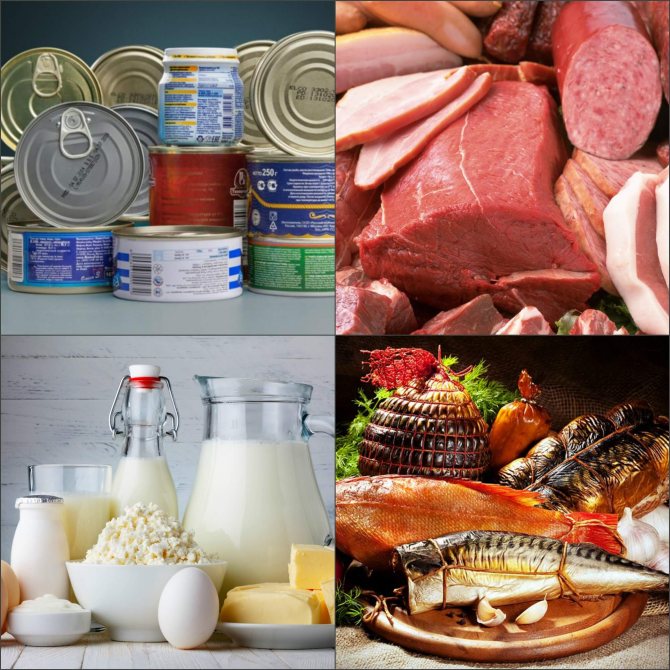
Products prohibited for consumption during weight loss are:
- meat and meat products;
- fatty fish;
- whole dairy products (hard cheese, butter, cottage cheese, fermented baked milk, pickled cheeses);
- cereals (except oatmeal);
- vegetable oils;
- canned food;
- smoked meats;
- pickles;
- confectionery and sweets;
- carbonated drinks;
- strong black tea and coffee.
Alcoholic drinks are prohibited: they stimulate appetite.
An approximate version of a vegetable diet for 2 weeks
Breakfast: orange and lemon juice (preferably freshly squeezed); any citrus. Lunch: vegetable salad from any non-starchy vegetables. Afternoon snack: a few prunes and dates. Dinner: salad of raw vegetables or boiled products of this type (priority turnips, spinach, cauliflower, carrots); any non-starchy fruit or nuts as a dessert.
Note
. This 14-day diet diet is not unchanged. You can create a menu at your own discretion, taking into account the basic dietary recommendations.
Advantages of a vegetable diet
- The undeniable advantages of vegetable weight loss include the beneficial properties of the main diet products - vegetables. If consuming other foods in large quantities can cause negative consequences, then vegetables, on the contrary, will enrich the body with many of the substances it needs.
- The process of losing weight, with a reasonable approach, will become an easy and pleasant pastime, during which you will feel rainbow changes, both in your figure and in your appearance.
- Also, the advantages of vegetable nutrition include the low cost of these products, especially during their season. Without purchasing, say, meat and fish products, you can save significantly.
- This diet is simply an ideal option for people who have their own garden or summer cottage where these healthy goodies grow.
- Vegetables have a gentle cleansing effect on the body, contribute to the natural normalization of the digestive process, increase immunity, giving the body strength to fight viral diseases.
- Vegetable products are also an excellent prevention of cardiovascular diseases and cancer, resist the occurrence of edema and the formation of kidney stones, and reduce the risks of diabetes and joint diseases (rheumatism and arthritis).
- The abundance of vitamins and nutrients found in vegetables has a positive effect on our appearance, strengthening nails, hair, making skin healthier and smoother. And in the future, do not minimize the amount of vegetable products in your diet, regardless of whether you are going to lose weight.
- Many who have transformed their body with the help of vegetables happily state the fact that with a smooth exit from the diet, the results obtained last for a long time.
- During a diet, the body quickly sheds extra pounds due to the low calorie content of the proposed diet.
- The presence of complex carbohydrates helps regulate blood sugar.
- A varied diet will not make the process of losing weight monotonous and boring and will not push you to want to quit everything as soon as possible.
Disadvantages of a vegetable diet
- The disadvantages of a vegetable diet are probably that it is not year-round. If you want weight loss to be not only effective for your figure, but also beneficial for your health, you should do it during the vegetable season. Otherwise, you will have to purchase products that are not only poor in useful substances, but also capable of harming the body due to the abundance of chemicals with which they are stuffed for long-term storage and attractive appearance.
- This technique may not be suitable for meat eaters (with the exception of the monthly diet). After all, vegetable diet options are not rich in this luxury. Although most people losing weight note that this diet is easily tolerated, for people who are accustomed to constantly eating meat, this technique can become difficult to use. In this case, nutritionists recommend not torturing yourself and choosing a more acceptable diet for you, which will also include vegetables, but there is also a place for meat (for example, protein-vegetable). Also, not all nutritionists consider a vegetable diet to be completely balanced in terms of the content of nutrients and minerals.
Vegetables and weight loss: which ones harm and which ones help
There are many ways to prepare food from vegetables. You can boil, stew, bake, dry and pickle. So, such a diet can surprise you with the variety of its menu and you won’t have to go hungry. Judge for yourself how rich a “herbaceous diet” can be: vegetables are divided into eleven groups.
- Tuberous. This includes potatoes and Jerusalem artichokes.
- Bulbous. These are garlic and all types of onions.
- Root vegetables. This group includes beets, carrots, radishes, parsley, horseradish.
- Salad. These include spinach, lettuce, and sorrel.
- Legumes. This includes beans, peas, beans.
- Brassicas. These are all varieties of cabbage.
- Solanaceae. These include tomatoes, peppers, and blueberries.
- Melons. These are cucumbers, pumpkin, zucchini.
- Spicy. There's basil and dill here.
- Dessert. These are, for example, artichoke and asparagus.
- Cereals. A representative of this group is corn.
Within the framework of dietary nutrition, vegetables should be divided into three categories. Some are simply safe for your figure. These are, for example, tomatoes, eggplants, carrots, zucchini. Others specifically address the problem of burning excess fat deposits. These include cabbage, cucumbers, beets, peppers and celery. And in the third category there is only one vegetable, but it is very dangerous for people prone to obesity. So, they get better from starchy potatoes.
